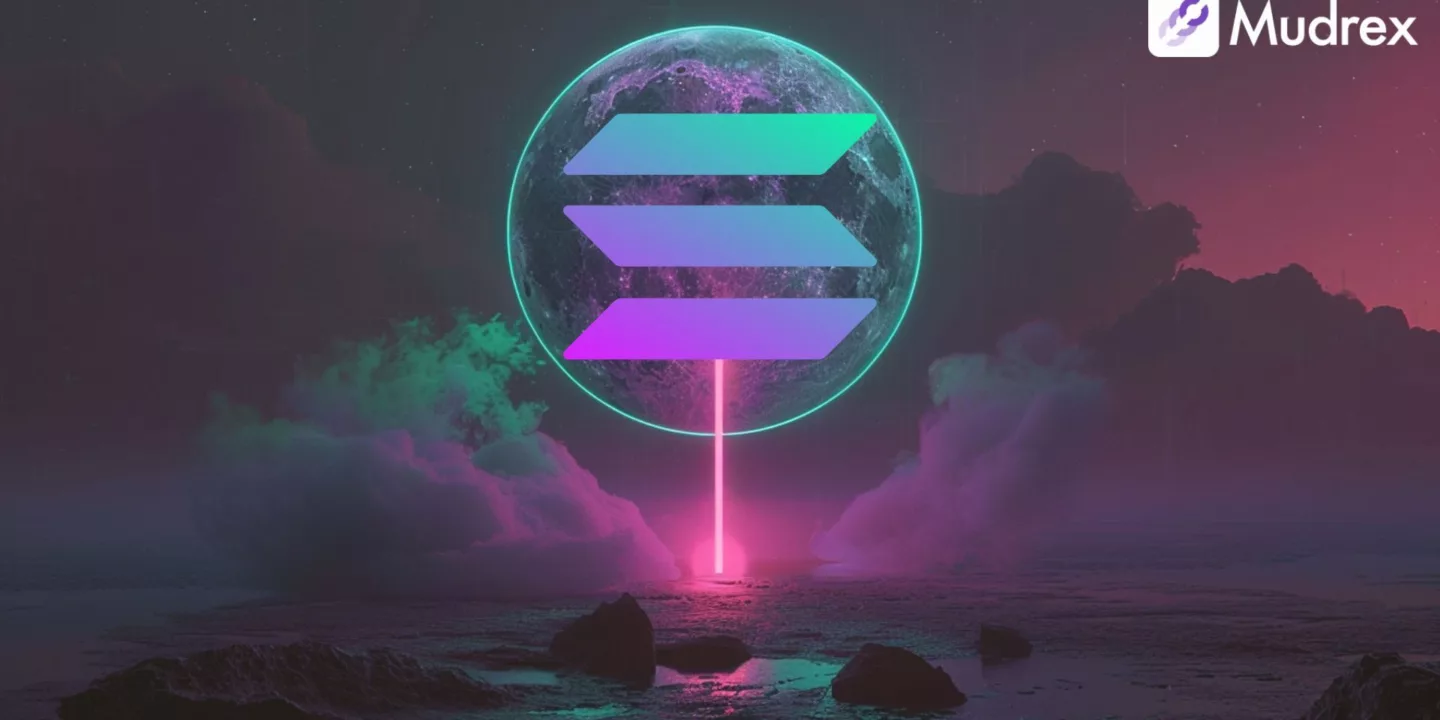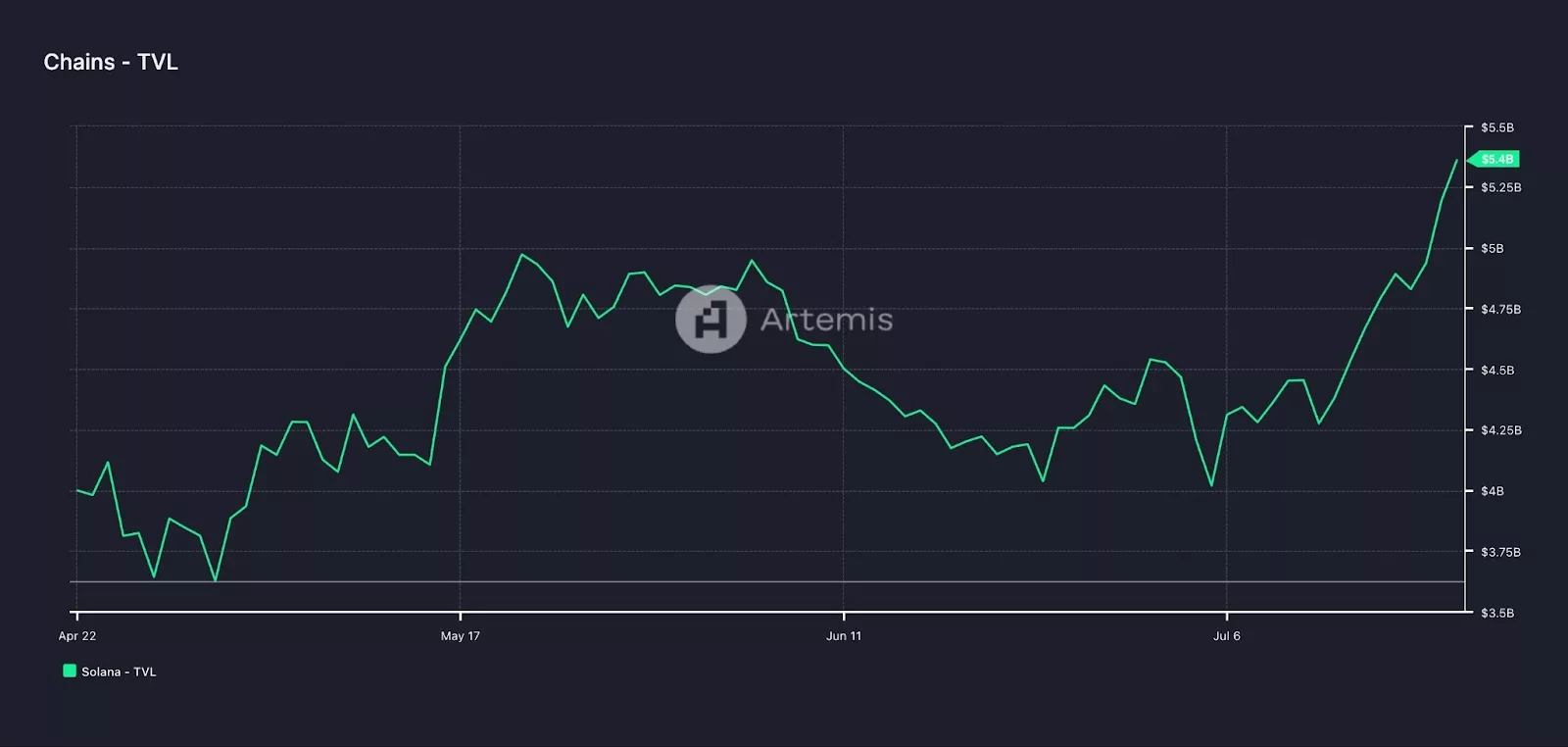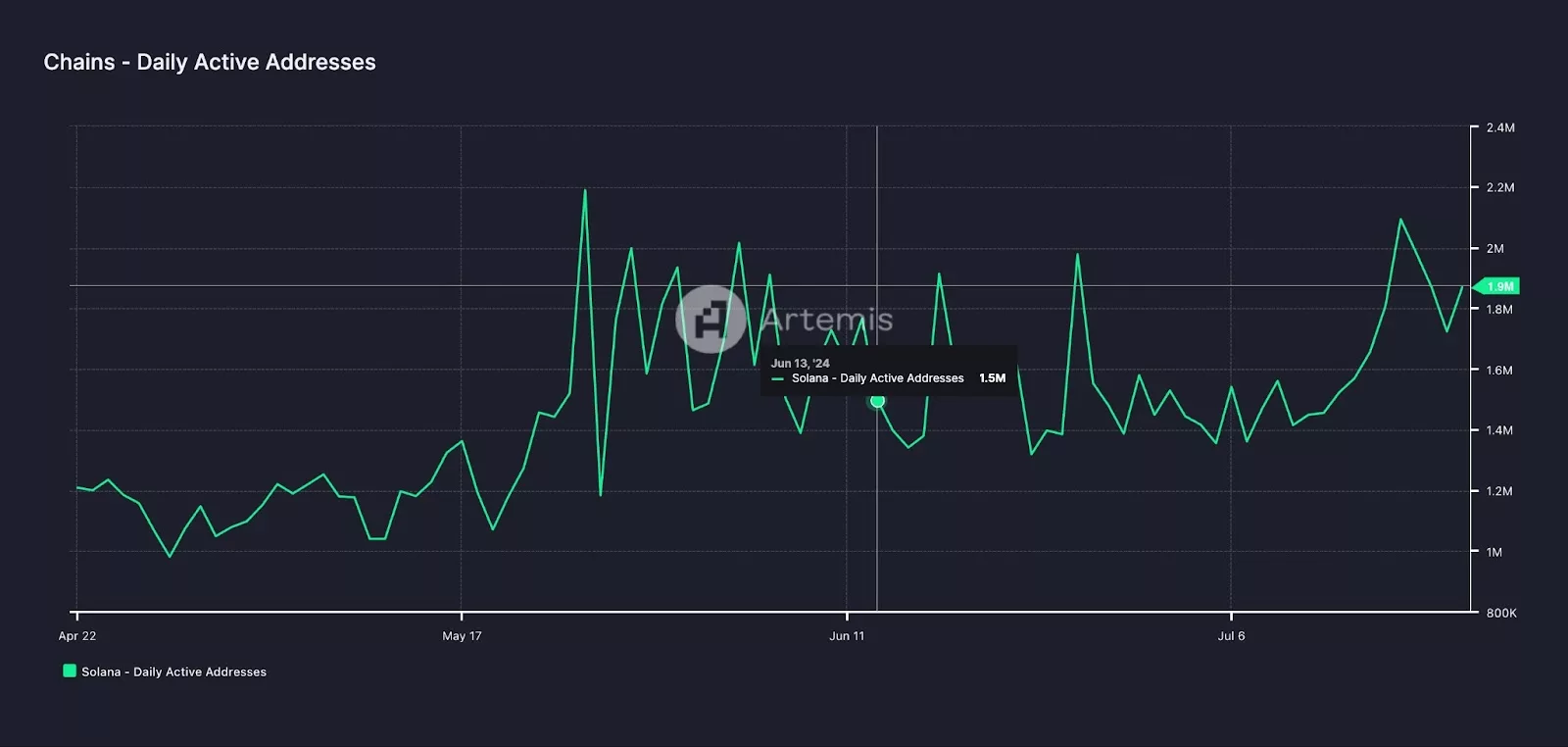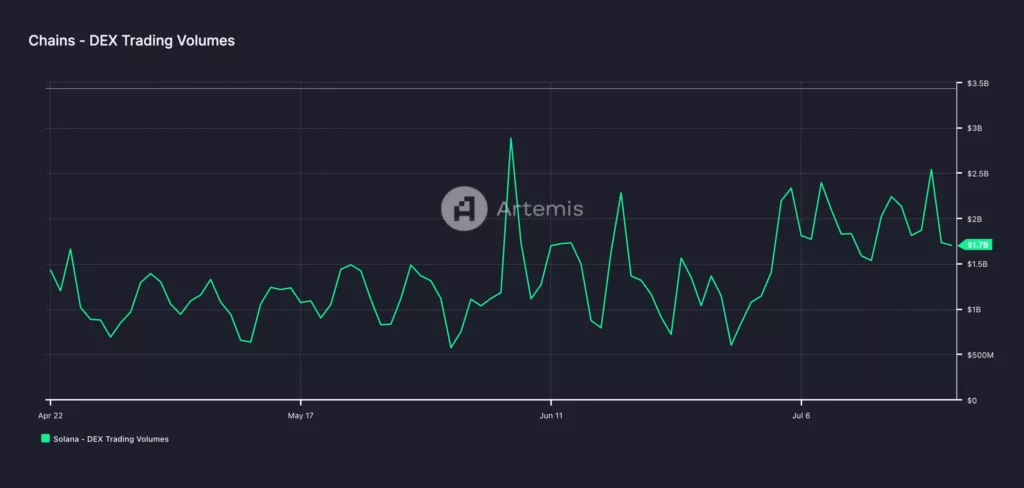
Step Aside ETH, SOL is The New Supercoin
Executive Summary
- Solana’s focus on speed and scalability has positioned it as a strong competitor to Ethereum. Recent on-chain metrics reflect Solana’s increasing influence and competitive stance.
- Solana faces centralization concerns due to a smaller validator pool, an inflationary token model that could dilute value, and past network instability. However, the Firedancer protocol aims to address centralization concerns by introducing a second validator client and supporting sharding to enhance scalability.
- These network updates have driven positive growth, as demonstrated by quarter-over-quarter increases in key on-chain metrics such as Total Value Locked (TVL), decentralized exchange (DEX) trading volume, and daily fee payers.
- With growing institutional interest and ongoing upgrades, Solana is actively working to overcome some of its limitations and solidify its position as the leading layer 1 blockchain.
In the thousands of crypto projects today, two notable networks stand out: Solana and Ethereum. Both are major layer 1 blockchains with vibrant communities and a range of projects across various web3 niches, including DeFi, NFTs, Memecoins, Web3 gaming, and more. Despite Ethereum’s first-mover advantage and its mature ecosystem of dApps, Solana has gained prominence due to its scalability and speed, offering strong competition to the pioneering smart contract network. The idea of Solana being an “Ethereum killer” isn’t new, but recent debates have intensified due to on-chain metrics showing Solana’s rising trends and, in some cases, surpassing Ethereum.
Before analyzing Solana’s growth compared to Ethereum, it’s essential to first understand the key differences between these two blockchains.
Solana vs Ethereum: Key Differences Through the Lens of the Blockchain Trilema
The blockchain trilemma, a term coined by Ethereum co-founder Vitalik Buterin, suggests that developers of decentralized blockchains must navigate three main factors: security, decentralization, and scalability. Despite their best efforts, developers often have to sacrifice one factor to optimize the other two.
Understanding the blockchain trilemma is crucial for evaluating different blockchain projects. Each project makes trade-offs between the three core principles, and the ideal choice depends on your specific priorities. With this context in mind, we compare Solana and Ethereum, examining their strengths and weaknesses.
Security
Ethereum:
Ethereum currently relies on a Proof of Stake (PoS) consensus mechanism. In this system, validators stake their own ETH tokens to verify transactions, with the risk of losing their staked tokens (a process known as “slashing”) if they don’t adhere to protocol rules or act against the network’s interests. Validators are rewarded financially through block proposals and transaction fees, gain influence over network governance, and bear the responsibility of maintaining network security. This mechanism ensures that validators remain committed to maintaining network integrity and reliability
Although PoS is a recent implementation for Ethereum, its history with the previous Proof of Work (PoW) system, along with ongoing security audits and Ethereum Improvement Proposals (EIPs) during the transition to PoS, fosters confidence in its security. This established track record provides reassurance for users who value a thoroughly tested and refined security model.
Solana:
Solana employs a unique security combination of Proof of History (PoH) and delegated Proof of Stake (dPoS). PoH creates a verifiable time record between transactions, preventing replay attacks through streamlined transaction ordering.
In Solana’s dPoS system, validators stake both SOL tokens and require specific hardware, increasing the cost of malicious actions. While Solana’s innovative security architecture shows promise, its relative novelty compared to Ethereum’s PoS might lead some users to favor Ethereum’s more established track record.
Solana’s approach supports high throughput and rapid transaction speeds but has also raised security concerns. The network has experienced outages and denial-of-service attacks, revealing vulnerabilities related to its design and smaller validator pool (around 1,500) compared to Ethereum. To address these issues, Solana has introduced measures such as the QUIC protocol and stake-weighted Quality of Service (QoS)[1] to enhance network performance, security, and resilience.
The QUIC protocol is a transport protocol that enhances data transfer stability and mitigates spam attacks, allowing for efficient communication among nodes in the Solana network. Meanwhile, stake-weighted Quality of Service (QoS) prioritizes transaction processing based on the amount of SOL staked, ensuring that validators with more stake have a proportional influence on the network’s bandwidth allocation, thus improving overall performance and resilience.
Decentralization
Ethereum:
Ethereum is widely recognized for its decentralization, supported by a vast network of nodes operated by numerous independent validators globally. This extensive distribution of power helps ensure that no single entity can easily manipulate the network. The transition to PoS further promotes decentralization by allowing anyone with 32 ETH to become a validator, thereby increasing participation and resilience against centralization risks.
Solana:
In Solana’s case, despite being lauded for its impressive throughput, its series of outages reveal a potential weakness in its methodology. Solana employs a different approach to decentralization with a Delegated Proof of Stake (DPoS) system, where validators are selected based on factors like stake size and network performance. This method enables faster transaction speeds but raises concerns about centralization, as validation power is concentrated among a smaller group of chosen validators. Ethereum has more than 1 million validators with 13,900 nodes, compared to Solana’s 1,500+ validators.
Solana’s network reliability issues have been highlighted by these disruptions. To address Solana’s reliability, the network is developing a permissionless validator set through its highly anticipated validator client software, Firedancer. Firedancer, implementing Solana’s version of PoS, aims to mitigate centralization concerns. By allowing anyone to run a validator node without prior network approval, Firedancer has the potential to significantly distribute validation power more evenly and enhance network decentralization over time.
Firedancer, developed by Jump Crypto [2], enhances Solana’s decentralization and security by introducing a second validator client. This diversification reduces reliance on a single client, mitigating risks from software bugs or attacks, and improving overall resilience. Additionally, Firedancer’s design supports sharding, significantly boosting transaction processing and scalability. By enabling more independent validators, Firedancer fosters a more decentralized network, ultimately strengthening the security and efficiency of the Solana blockchain.
Scalability
Ethereum:
As more retail users adopt blockchain technology, networks must handle increasing transaction volumes without compromising processing speeds or incurring high fees. Ethereum, while robust in security and decentralization, has struggled with scalability – an area where Solana excels. Following its transition to a PoS consensus model and upgrades like Dencun, the Ethereum network currently processes around 15-30 transactions per second.
Regarding gas fees, network upgrades in recent years have significantly reduced the cost of transacting on the Ethereum network, from around $30 per transaction to approximately $3. That said, these fees fluctuate based on network congestion, ranging between $1 and $9 over the past three months.
Solana:
Since its launch, Solana has prioritized scalability and speed as its core strengths. Innovations like Proof of History (PoH) and Tower Byzantine Fault Tolerance (BFT) allow Solana to theoretically handle up to 65,000 transactions per second. Furthermore, Solana’s gas fees average around 0.00064 SOL, approximately $0.11, making it significantly more cost-effective than Ethereum.
This combination of rapid transaction speeds and minimal fees distinguishes Solana, making it a preferred platform for a variety of dApps, especially those demanding high throughput and cost efficiency. While Solana has yet to achieve its theoretical maximum throughput, advancements with Firedancer are promising. In test environments, Firedancer has achieved processing speeds of 600,000 transactions per second, suggesting significant potential for further scalability improvements.
Overall, Solana is pushing the boundaries towards overcoming the blockchain trilemma. The network is tackling concerns about centralization while significantly enhancing its scalability. With PayPal’s stablecoin launching on Solana [3], Stripe announcing USDC payments on the network [4], and institutions increasing their exposure to the cryptocurrency [5], these upgrades are certainly drawing attention.
Tracking Solana’s Explosive Growth Through On-Chain Data
Financial Metrics
In terms of financial metrics, Solana’s DeFi TVL fell by 9% QoQ to $4.5 billion, though it grew by 26% QoQ when denominated in SOL. The average daily spot DEX volume increased by 32% QoQ to $1.6 billion, with Raydium’s volume rising by 77% QoQ to $867 million. SOL’s market cap decreased by 25% QoQ to $68 billion, while the total economic value increased by 41% QoQ in SOL terms to 967,000 SOL ($151 million), driven primarily by transaction fees and MEV tips.

Network metrics
Network metrics indicated that average daily NFT volume fell by 56% QoQ to $3.4 million, with Magic Eden reclaiming the majority share of organic volume. The number of active daily fee payers grew by 51% QoQ to 900,000, and new daily fee payers surged by 114% QoQ to 247,000. The network maintained an average of 70 million daily non-vote transactions, despite experiencing congestion from spam transactions related to meme coin trading and Ore mining, which was alleviated by mid-April. The number of active addresses saw a significant increase, rising from 1.2 million in mid-April to 1.9 million by mid-July, marking a notable growth within just a few months.

Adoption metrics
Adoption metrics showed Solana’s expanding influence in the DEPin sector, with Helium Mobile’s new licensing program, Shaga’s $1 million raise, io.net‘s token launch ending at a $325 million market cap, and Teleport’s expansion to Austin, Texas. Memecoin trading continued to drive DEX activity, with tokens like WIF, MEW, POPCAT, and GME leading in trading volume.
Meanwhile, Pump.fun, a gamified token launch platform, collected $48 million in total Q2 fees and became a widely discussed application across the crypto community, averaging $525,000 in daily fees. These developments underscore Solana’s continuous efforts to enhance its network capabilities, expand its ecosystem, and drive adoption in various sectors.

Solana Technical Analysis
In the past week, Solana has demonstrated impressive performance, yielding returns of 16.2%. This performance stands out even among the top market-cap giants. The market sentiment towards Solana and its associated tokens, including SOL-based meme coins, remains highly bullish. This bullish sentiment has propelled the prices of key Solana ecosystem coins like Jupiter, Raydium, and Ponke.
On the technical front, SOL has been forming a large symmetrical triangle on the daily timeframe. Within this pattern, a double bottom formation has emerged, signaling a bullish breakout. As expected, SOL experienced a substantial rally, climbing from $135 to $185. After retesting $172, SOL is now challenging the $185 level once again. The next significant target is $200, with potential to revisit this year’s all-time high of $210.
Further analysis reveals that the daily MACD (levels 12, 26) is turning bullish, currently valued at 8.50. The RSI stands at 65.71, indicating there is still room for upward movement. Additionally, Solana has respected the 200 EMA, providing further hope for continued bullish momentum. These major indicators suggest a continued bullish momentum, reinforcing the potential for further gains in the near term.

Limitations of the Solana Network: Key Considerations
Solana offers an attractive combination of speed, scalability, a growing ecosystem, and an active community, making it a significant player in the crypto space. However, before investing in Solana, it’s essential to understand certain limitations of the network.
Centralization Concerns
Solana’s efficient architecture has raised concerns about centralization. The network relies on approximately 1,500 validators, significantly fewer than other blockchains like Ethereum. This can lead to centralization risks, as a smaller number of entities control the validation process.
Inflation
Many investors turn to cryptocurrencies as a hedge against inflation. Solana’s inflation rate is set at 8% per year, decreasing by 15% annually until it reaches an indefinite rate of 1.5%. This continuous creation of new SOL tokens can dilute the value of existing holdings over time. In contrast, Ethereum has adopted a deflationary model, particularly after implementing EIP-1559, which introduced a mechanism to burn a portion of transaction fees. Consequently, the number of ETH tokens entering circulation can be lower than the number being burned, leading to a net reduction in supply.
Network Stability
Since its launch, Solana has experienced several outages and periods of instability. In 2022 and early 2023, the network faced multiple outages due to various issues, including denial-of-service attacks. As recently as February 2024, the Solana network was down for five hours. Despite efforts to enhance long-term stability, these outages have raised concerns about Solana’s reliability.
Conclusion
Solana, having entered its second market cycle since its mainnet launch in March 2020, has rapidly ascended to become the fourth-largest cryptocurrency. The network is entering a new phase of maturity from being a retail driven chain to institutions taking notice for its speed and scalability.
As new layer 1 projects emerge, Solana must navigate the challenge of staying at the forefront of innovation. To ensure its long-term success, the network needs to adapt to shifting market conditions, manage regulatory uncertainties, and maintain its competitive edge. By consistently advancing its technology, nurturing a diverse and decentralized ecosystem, and addressing user concerns, Solana can reinforce its position as a leading blockchain network.
References
- Jump Crypto, “Solana’s Firedancer: Enhancing Decentralization and Scalability,” Jump Crypto.
- Artemis, “Solana Financial and Network Metrics,” Artemis.
- CoinDesk, “PayPal Launches Stablecoin on Solana,” CoinDesk.
- Stripe, “USDC Payments on Solana,” Stripe.
- CryptoQuant, “Institutional Interest in Solana: Increasing Exposure to Cryptocurrency,” CryptoQuant.
- Artemis, “Tracking Solana’s Explosive Growth Through On-Chain Data,” Artemis.





